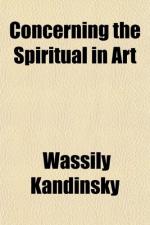Musical sound acts directly on the soul and finds an echo there because, though to varying extents, music is innate in man. [Footnote: Cf. E. Jacques-Dalcroze in The Eurhythmics of Jacques-Dalcroze. London, Constable.—M.T.H.S.]
“Everyone knows that yellow, orange, and red suggest ideas of joy and plenty” (Delacroix). [Footnote: Cf. Paul Signac, D’Eugene Delacroix au Neo-Impressionisme. Paris. Floury. Also compare an interesting article by K. Schettler: “Notizen uber die Farbe.” (Decorative Kunst, 1901, February).]
These two quotations show the deep relationship between the arts, and especially between music and painting. Goethe said that painting must count this relationship her main foundation, and by this prophetic remark he seems to foretell the position in which painting is today. She stands, in fact, at the first stage of the road by which she will, according to her own possibilities, make art an abstraction of thought and arrive finally at purely artistic composition. [Footnote: By “Komposition” Kandinsky here means, of course, an artistic creation. He is not referring to the arrangement of the objects in a picture.—M.T.H.S.]
Painting has two weapons at her disposal:
1. Colour.
2. Form.
Form can stand alone as representing an object (either real or otherwise) or as a purely abstract limit to a space or a surface.
Colour cannot stand alone; it cannot dispense with boundaries of some kind. [Footnote: Cf. A. Wallace Rimington. Colour music (op. Cit.) where experiments are recounted with a colour organ, which gives symphonies of rapidly changing colour without boundaries— except the unavoidable ones of the white curtain on which the colours are reflected.—M.T.H.S.] A never-ending extent of red can only be seen in the mind; when the word red is heard, the colour is evoked without definite boundaries. If such are necessary they have deliberately to be imagined. But such red, as is seen by the mind and not by the eye, exercises at once a definite and an indefinite impression on the soul, and produces spiritual harmony. I say “indefinite,” because in itself it has no suggestion of warmth or cold, such attributes having to be imagined for it afterwards, as modifications of the original “redness.” I say “definite,” because the spiritual harmony exists without any need for such subsequent attributes of warmth or cold. An analogous case is the sound of a trumpet which one hears when the word “trumpet” is pronounced. This sound is audible to the soul, without the distinctive character of a trumpet heard in the open air or in a room, played alone or with other instruments, in the hands of a postilion, a huntsman, a soldier, or a professional musician.
But when red is presented in a material form (as in painting) it must possess (1) some definite shade of the many shades of red that exist and (2) a limited surface, divided off from the other colours, which are undoubtedly there. The first of these conditions (the subjective) is affected by the second (the objective), for the neighbouring colours affect the shade of red.




